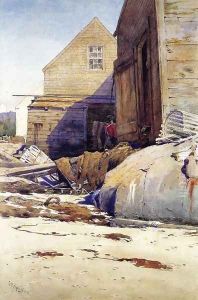Samuel Triscott Paintings
Samuel Peter Rolt Triscott was an English painter known primarily for his watercolor landscapes. Born on January 4, 1859, in Gosport, Hampshire, England, Triscott displayed artistic talent from a young age. Trained as a civil engineer, he initially pursued a career in engineering but later devoted himself full-time to painting after moving to the United States.
In the early 1880s, Triscott settled in Boston, Massachusetts, where he became associated with the American watercolor movement. He was particularly influenced by the works of American artists such as Winslow Homer and John Singer Sargent, as well as the British tradition of watercolor painting. Triscott was known for his ability to capture the atmospheric effects and the play of light on landscapes, which was a hallmark of his style.
Triscott's work gained recognition, and he became a member of the Boston Art Club and the American Watercolor Society. He traveled extensively throughout New England, particularly in Maine, where he painted coastal scenes, harbors, and rural landscapes. His paintings are characterized by a delicate touch and a keen eye for detail, which allowed him to render the subtleties of the natural environment.
In addition to his New England scenes, Triscott also painted landscapes during his travels abroad to places like Italy and Bermuda. These paintings further demonstrate his versatility and skill in capturing different kinds of light and atmosphere.
Triscott's health began to decline in his later years, and he eventually moved to Pasadena, California, seeking a better climate. He continued to paint until his death on March 27, 1925. Today, Samuel Peter Rolt Triscott's works are held in various collections and are appreciated for their contribution to the American watercolor tradition. His legacy is that of a skilled watercolorist who brought the beauty of the American and international landscapes to life with sensitivity and a masterful control of his medium.
